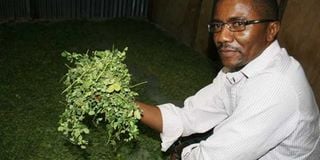More than a sweet deal in moringa

Mr Winstone Edward samples moringa harvest at his Kisumu office. PHOTO | JACOB OWITI
What you need to know:
- After facing numerous challenges growing rice, farmers in Kisumu switch to moringa to earn Sh7,500 a week
After years of grappling with poor income from rice cultivation, farmers in Kisumu County have ditched the crop and embraced moringa, a medicinal plant.
Moringa is a plant whose origin is believed to be India. It is used in the treatment of arthritis, cancer, asthma, stomach pains, heart problems and parasitic infections, among other diseases.
Kisumu residents call it mti mboga because of its diverse benefits.
“I have made up my mind not to grow rice again,” says Jane Nyangota, 40, a resident of Awasi, who is growing the crop.
With moringa, Jane has put behind heavy losses she used to incur due to floods, exploitation by middlemen, lack of storage and milling facilities, the challenges she endured when she was growing rice.
Like rice, moringa takes about three months to mature.
“In terms of farming, I do not see much difference between the two. However, there is ready market for moringa, unlike rice.”
There are two ways to grow moringa.
“If the ground is wet, you can soak the seeds overnight, then plant the following day. Farmers are encouraged to soak the seeds to hasten germination,” says Mr Zakayo Odhiambo, an agronomist.
The soaked seeds take about four to five days to germinate.
A farmer can also plant 20 to 30cm moringa stems, just as it happens with cassava.
This will take about one week to start germinating. Odhiambo says this method allows for quick germination if it is done in wet soil. He cautions that the soil should not be waterlogged since the plant can rot.
Jane, like many other farmers in Kisumu, prefers planting directly because it is easier.
After harvesting the plant’s leaves and seeds, she dries them and takes them to Edom Nutritional Solutions (ENS), a company that offers farmers ready market for the product, thus encouraging the switch from rice to moringa.
“I started supplying the company based in Kisumu with moringa powder in 2011. I take 30kg of powder and 5kg of seeds in a week.”
A kilo of moringa powder costs Sh600 while the same quantity of seeds goes for Sh400.
Stephen Ong’ondo, another moringa farmer, says the guaranteed market for the produce has assured him of steady income. “I supply Edom with at least 30kg of powder twice a week,” says Ong’ondo.
Winstone Odhiambo, 38, the owner of ENS, describes moringa as a slender, fast-growing and deciduous shrub.
“The plant is small and reaches up to 15 metres in height. It is exceptionally nutritious and can tolerate hostile conditions and poor soils,” he says.
The Egerton University alumnus says Edom started while he was working with a women’s group in Kisumu.
“I realised the women lacked skills in value addition aspects of moringa.”
He later left the group, but he had spotted a business opportunity. “I made moringa porridge flour and took it to Kenya Industrial Research and Development Institute for testing. I was advised on how to improve my product.”
In 2010, he sold a portion of his father’s land to raise Sh600,000. He used part of the money to rent an office at Nyamasaria and bought various equipment for his business.
The machines included cereals’ cleaner, maize huller, milling machine, spiral miller for mixing the ingredients and weighing scales. “I am happy that I have been able to change farmers’ lives through the project. They are getting the great for their efforts,” says Odhiambo.
Edom director of sales Michael Ohula says moringa has become a cash crop for small-scale farmers in Nyanza.
“We started with farmers in Kisumu but we have now expanded to Bungoma, Migori and Siaya counties. The farmers plant the crop, dry the produce and sell to us.”
A farmer can plant up to 5,000 moringa plants on an acre. Each plant yields an average of 2kgs of leaves per harvest.
When the leaves are dried and ground, they produce 200gms of powder.
The leaves can be ground on a grinding stone at home or posho mill. Moringa can be harvested for a maximum of 10 years.
ENS uses moringa powder to make nutritious porridge flour available in the market.
The ingredients include soya beans, finger millet, sorghum and cassava, besides moringa powder itself.
“We put them into a spiral mixture. The mixture is then ground. It is then packaged in 250gm, 500gm and 1kg packets” says Odhiambo.
GROWING MORINGA
Kenya Industrial Research and Development Institute scientist Daniel Ojwang says moringa can grow in tropical and semi-arid climates, making it a viable solution for areas affected by food shortages and populations susceptible to malnutrition.
He notes moringa is not only nutritious but also produces fuel, enhances other crops growth if intercropped, produces livestock feed, purifies water and produces medicine.
“Because of its high nutritional value, moringa is positioned as a healthy edible plant because it is a good source of vitamins and minerals essential for our health.”
Due to its effect in milk production and quality, breastfeeding mothers are encouraged to use it. That is why it’s referred to as mother’s best friend.




